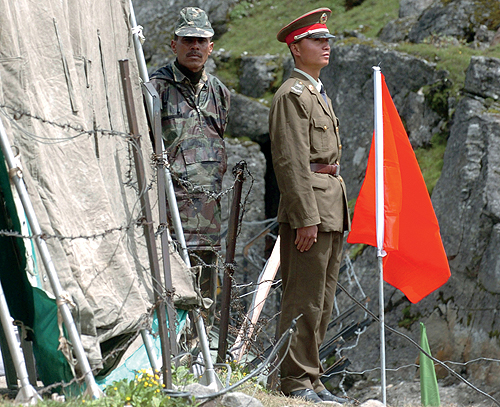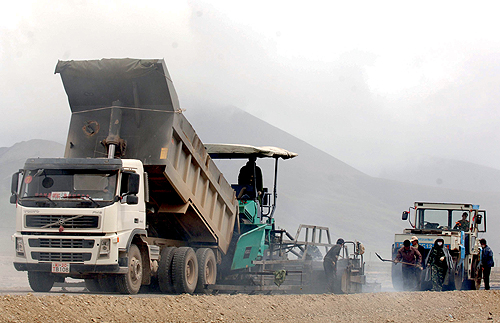|
 |
|
SHOULDER TO SHOULDER: A Chinese soldier and an Indian soldier keep guard across barbed wire at the Nathu La Pass along the China-India border on July 5, 2006. The next day, the area was reopened to restore the border trade post after more than 40 years of interrupted use |
Despite the rapid development of China-India relations in recent years, trade between the two countries only takes up a fraction of their total foreign trade volumes. Economic Information Daily, a Beijing-based newspaper, has published a report on China-India bilateral economic and trade relations, offering a full picture of the existing constraints.
Edited excerpts follow:
Since the 1990s, China and India have enjoyed a renaissance in the development of bilateral economic and trade relations, owing to the improvement of their political and diplomatic ties. But read the statistics over the years, and one will soon discover that's not the whole picture. Actually, China-India trade accounts for less than 2 percent of China's total foreign trade volume and less than 6 percent of India's total. This proves constraints exist.
Poor transportation conditions
On June 5, more than 300 commerce officials, entrepreneurs and scholars from China and South Asian countries gathered in Kunming, Yunnan Province, to discuss expanding regional economic and trade cooperation. Caught in trade deficits and economic underdevelopment, South Asian countries said conquering the ongoing financial crisis would be a big opportunity with which to open up the Chinese market, while attracting Chinese capital and technological support.
Chinese-Indian trade volume, for instance, has soared to 10 times its original level in the past seven years. In 2008 alone, the figure reached $51.8 billion. Vishambhar Saran, Vice President of the Indian Chamber of Commerce, said China-India trade would further prosper as the economy improves.
Li Li, a researcher at the Yunnan Academy of Social Sciences, said that, although China and India are connected by land, their current trade mainly passes the Strait of Malacca. However, she added, the marine route is so far away that the time and cost restrain fuller economic and trade cooperation.
On the other hand, the time needed to traverse land routes has been dramatically shortened with the rebuilding of the Stilwell Road that links China and India via Myanmar and the reopening of the Nathu La Pass for border trade. But still, problems remain for a number of reasons. For example, road conditions are extremely poor, thus requiring increased road construction for areas on both sides of the border.
The land and air routes that can most easily shorten China-India trade distance traverse north and northeast India, where extreme poverty has led to deterioration of basic facilities and traffic systems.
All these factors pose significant challenges to bilateral trade relations.
Fragile political trust
China-India trade relations are an economic issue, but political and security factors are influential, too. Generally, bilateral understandings between Beijing and New Delhi are far from sufficient due to their limited exchanges. Barring a handful of recent visits by officials, businesspeople and scholars, peoples of the two countries know little about each other's conditions and policies.
In other words, mutual trust is superficial and, in ways, fragile.
Time has borne this out. Some Indians, moreover, are wary that China's cooperation with Pakistan, a long-time nemesis, might be a threat, thus prompting them to hold a defensive posture.
 |
|
EXPANDING TRADE ROUTES: Workers rebuild a road 4,500 meters above sea level in Xigaze, Tibet Autonomous Region, on July 1, 2007. The 165-km road is the largest land trade corridor between China and India | This, in turn, could result in a fast and serious erosion of trust between Beijing and New Delhi.
Then there is the "China threat" theory: an Indian fear of China's rapid development, along with an aversion to Chinese products. This has diminished the Chinese market in India.
Noticeable trade imbalance
China-India trade has long stayed even, despite the two countries' low level of cooperation. However, a big transition took place in 2006, when India's trade with China dropped precipitously—to a deficit of $4.12 billion, down from a surplus of $800 million the year before. And, in 2007, the deficit became even greater. Inside India, much was made of this seismic shift.
|
